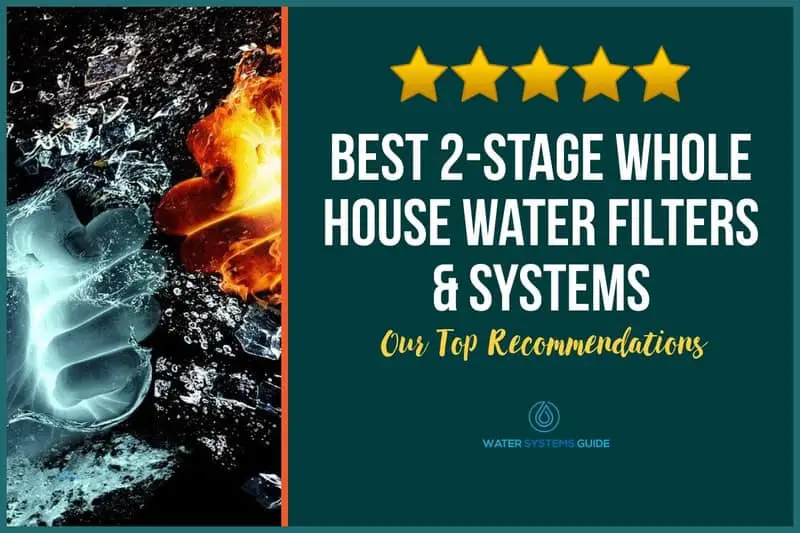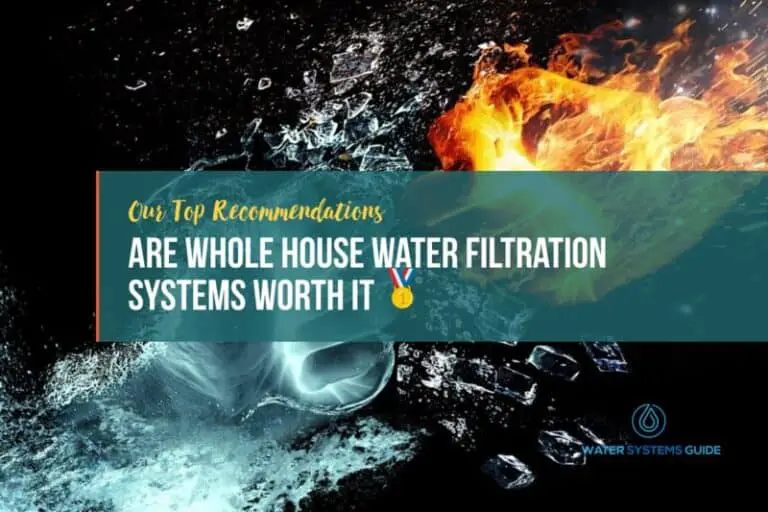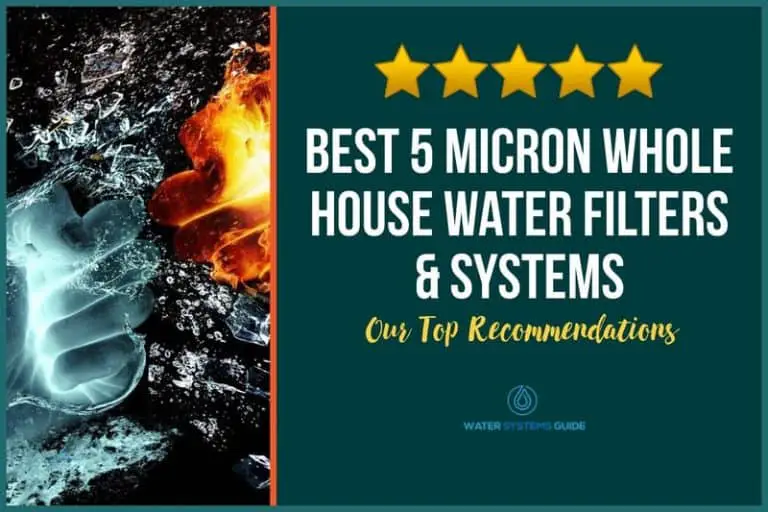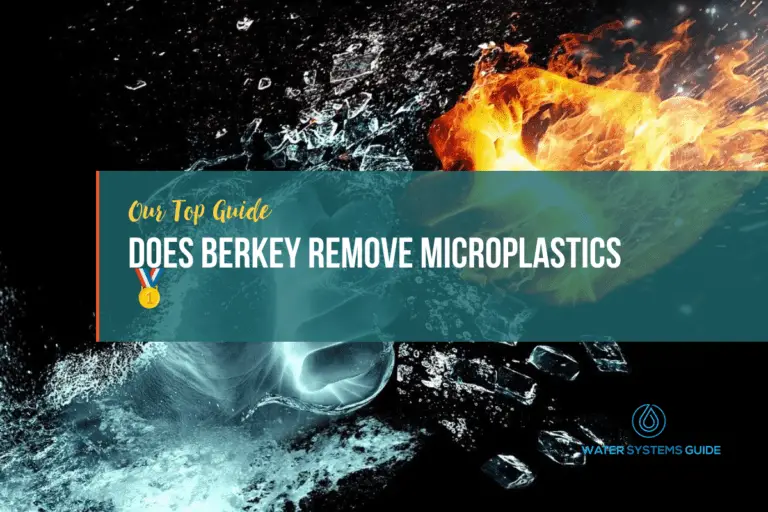5 Best 2-Stage Whole House Water Filters & Systems (April 2025)🥇
Last Updated: 09 April 2025
In this article, we’re going to be talking about the best 2-Stage Whole House Water Filter Systems from your water supply, which are available on the market.
In addition to removing pollutants from your potable water, the two-stage whole house water filtration systems also improve the smell and the taste of the same. On top of that, it reduces water’s hardness to make sure that it gives you healthy-looking hair and skin, and leaves fewer stains on your dishes.
That said, not all house water filter systems are created equal.
That means that if you want to get the best home water filtration system, what you need is someone to identify the features which separate the best units from the also-rans. At the same time, you need to have one eye on your budget to make sure that you get good value for your money.
Think that’s something that’s beyond you? Don’t worry as this article will help you out.
✅What is a whole house water filter system?
As the name implies, whole house water filter systems remove impurities, pollutants, and other harmful substances from the tap water of your home.
It is able to do that by installing a point-of-entry system which works by channeling all the water through a filtration media.
That means that in contrast to, say, an undersink water filter, you won’t see multiple water filters of the same whole house system throughout your house. Instead, it has a standalone water filter that gets the job done on its own.
Best 2-Stage Whole House Water Filters Review – Top 5
- iSpring WGB21B 2-Stage Whole House Water Filter – 50,000 Gal – $ – Skip to section
- iSpring WGB22B 2-Stage Whole House Water Filter – 80,000 Gal – $$ – Skip to section
- Home Master HMF2SmgCC Whole House System – 95,000 Gal – $$$ – Skip to section
- iSpring WGB22BM Whole House Water Filter – 100,000 Gal – $$ – Skip to section
- Express Water Whole House Water Filter – 100,000 Gal – $$ – Skip to section [#1 Recommendation – Fantastic Specs & Customer Reviews, Inc Stand]
iSpring WGB21B 2-Stage Whole House Water Filter – $
The iSpring WGB21B is the first 2-stage whole house water filter system that we’ve included in this list. It specifically filters chlorine and is highly effective at filtering out other organic compounds like herbicides and industrial solvents.
Technical Specs
- Filter Stages: 2
- Micron: 5
- Rate: 15GPM
- Capacity: 50,000 Gal
- Chlorine Removal: Up to 95%
General Specs
- Price: $
- Dimensions: 17 x 18 x 9 inches
- Weight: 15 pounds
- Kit includes: 1 sediment filter, 1 carbon block filter, 1 set of installation kit
- Warranty: 1-year
Features
What we don’t like
Reviews suggest that the installation of the unit can require steady hands, making sure that the inlet and outlets are secure.
Pros
- Rate of 15GPM
- 50,000 gallons of water filtering capacity
Cons
- Installation requires steady hands
iSpring WGB22B 2-Stage Whole House Water Filter – $$
The iSpring WGB22B is a 2-stage whole house system that relies on a residue and carbon filter to eliminate all the commonly found contaminants from your house water. Throw into the mix its excellent flow rate of 15 gallons per minute, and you can’t find much that is wrong with this water filter.
Technical Specs
- Filter Stages: 2
- Micron: 5 and 5
- Rate: 15GPM
- Capacity: 80,000 Gal
- Chlorine Removal: Up to 99%
General Specs
- Price: $
- Dimensions: 5 x 8.5 x 26 inches
- Weight: 33 pounds
- Kit includes: black metal bracket, two big blue housings with caps, two filter cartridges, and a 4. 5-inch housing wrench, house water filtration system
- Warranty: 1-year
Features
First things first, the fact that this unit comes with two-stages means it gets one-up over units that use on one cartridge to purify your water. The first of them is a 5-micron high filter capacity residues filter which, as the name implies, eliminates silt, dust, and residues.
As for the second of the two filters, it relies on carbon block material to not only freshen up the taste and eliminate odor from your water but also keep the likes of chlorine, pesticides, herbicides and even VOCs at bay, thereby making the entire unit suitable for municipal or city treated waters.
Compared with other whole house water filters you can find on the market, the installation of the iSpring WGB22B is perhaps the easiest. All you’d have to do is to attach the inlet and outlet pipe against the PVC header, before connecting the PVC pipe to your house’s plumbing using a proper sealer.
Other than that, since the housing of both filters is equipped with the same 1’’ port, that allows the filter to provide an excellent water flow rate of up to 15GPM. The filters supply up to 80,000 gallons of water before needing replacement, which translates to 1 year of water treatment for a family of 4.
What we don’t like
Reviews suggest that the installation of the unit can require steady hands, making sure that the inlet and outlets are secure.
Pros
- Rate of 15GPM
- 80,000 gallons of water filtering capacity
Cons
- Installation requires steady hands
Home Master Whole House System – $$$
Although this unit lacks behind the iSpring WGB22B filter when it comes to its rate, the fact that it filters out particles with a smaller micron size and boasts a higher filtering capacity makes the Home Master Whole House Water Filter a formidable option too.
Technical Specs
- Filter Stages: 2
- Micron: 1
- Rate: 10GPM
- Capacity: 95,000 Gal
- Chlorine Removal: Up to 95%
General Specs
- Price: $$
- Dimensions: 9 x 18 x 25 inches
- Weight: 4 pounds
- Kit includes: fully assembled Home Master Filter system with filters, steel mounting bracket with bolts, housing wrench, and instructions, water filtration system.
- Warranty: 2-year
Features
Starting with the best that this unit has to offer, its catalytic filter provides a full year of clean house water by treating 95,000 gallons before needing replacement. That too while making sure that both of its filters eliminate particles as small as 1 micron from your house water.
Turning our attention to how it would keep the contaminants out, this 2-stage filter relies on a combo of an outer residues filter and an inner catalytic filter to keep things clean, with the external filter preventing the likes of dust, dirt and other particles from making their way into the system.
As for the internal catalytic filter, its high-grade coconut shell empowers the filter to eliminate taste, odor, and chemicals from your house water. The granular activated media of the filter, meanwhile, allows it to keep the likes of heavy metals (lead, copper, and mercury) away from your water.
Furthermore, since this system is equipped with a standard 1-inch port, you can expect to get more than 10GPM of rate at all times. Granted, it isn’t as impressive as the one offered by the iSpring WG22B, but the flow rate of this unit is better than what is offered by most water filters on the market.
What we don’t like
What is it that we don’t like about this unit? Neither of the two filters which are supplied alongside the unit doesn’t come cheap.
Pros
- Filters particle as fine as 1 micron
- Market-best volume
- Impressive rate
Cons
- Considerable filter replacement prices
iSpring WGB22BM Whole House Water Filter – $$
In contrast to the other iSpring unit which we reviewed earlier – whose specialty lies in its fine residues and carbon filters – the iSpring WGB22BM, apart from dealing with the normal contaminants, proves its utility when dealing with the likes of iron, manganese and other heavy metal substances.
Technical Specs
- Filter Stages: 2
- Micron: 5
- Rate: 15GPM
- Capacity: 100,000 Gal
- Chlorine Removal: Up to 99%
General Specs
- Price: $
- Dimensions: 16 x 8 x 27 inches
- Weight: 40 pounds
- Kit includes: black metal bracket, two big blue housings with caps, two filter cartridges, and a 4. 5-inch housing wrench,
- Warranty: 1-year
Features
What makes the iSpring WGB22BM different from other units from the same manufacturer is its ability to protect your household appliances. It reduces the likes of iron and manganese sediment from your water to make sure that when used for washing, it doesn’t end up leaving scales on your appliances.
What’s more, while whole house reverse osmosis systems are undoubtedly more popular, this unit shows that you could do better without reverse osmosis systems. That is, because, while reverse osmosis systems treat everything in the same fashion, this device ignores the healthy minerals and lets them pass through.
Moving on, while the first of the two stages main eliminate taste, odor and other commonly found pollutants, the 2nd stage is where this unit shows its true worth. Made of iron and magnesium reduction filter, it chiefly eliminates iron, arsenic, and manganese from source water.
Despite being so picky while dealing with contaminants, this unit provides the same 15GPM flow rate which is offered by most iSpring units. One area where this unit performs better than its colleagues is its volume. While most of them stop short at 85,000 gallons, this device goes all the way up to 100,000.
What we don’t like
Once you factor in the yearly replacement prices of the cartridge – which exceeds $100 – and this unit comes across as an expensive system.
Pros
- 100,000 gallons filtering capacity
- Eliminates iron and manganese
- Allows healthy minerals to remain
Cons
- Pricey
Express Water Whole House Water Filter – $$]
#1 Recommendation – Fantastic Specs & Customer Reviews, Inc Stand
This Express Water filter is best suited for those who have larger houses or residential accommodation, with its 100,000-gallon filter capacity and it’s ability to deliver up to 0.25 gallons of water per second.
Technical Specs
- Filter Stages: 2
- Micron: 5
- Rate: 15GPM
- Capacity: 100,000 Gal
- Chlorine Removal: 97%
General Specs
- Price: $
- Dimensions: 29 x 8.5 x 16 inches
- Weight: 36 pounds
- Warranty: 1-year
Features
The Express Water 2 Stage Whole House Sediment and Carbon Water Filter removes major contaminants from your water supply and provides clean water all home uses. This system removes contaminants like Rust, Dirt, Sand, Silt, Dust, Scale, Chlorine, Pharmaceuticals, Turbidity, Volatile Organic Chemicals (VOC), Industrial Solvents, Insecticides, Pesticides, Chemicals causing bad tastes, odors, and more.
The Whole House System is designed to be easy to use and efficient. A filter is good for up to 100,000 gallons or 6-12 months, depending on incoming water quality. Your filter life may be different depending on your water quality, temperature, and incoming pressure. Comes complete with a Sediment and Carbon Block Filter. The large 1” connections and long high-efficiency housings are designed for almost no reduction in your home’s water pressure.
This durable, heavy-duty whole house system able to deliver up to 0.25 gallons of water every second. The system comes fitted to a stainless steel freestanding frame which allows for installation on the ground or a mounted installation. This system is designed to be used in a dry level area protected from freezing temperatures and direct sunlight. The system works with 45-80 psi and water temperatures between 40-100 °F. The system includes a pressure release button and pressure gauge for system monitoring.
What we don’t like
Once you factor in the yearly replacement prices of the cartridge – which exceeds $100 – and this unit comes across as an expensive system.
Pros
- 100,000 gallons filtering capacity
- Eliminates iron and manganese
- Allows healthy minerals to remain
- Comes with free standing frame
- Fantastic customer reviews
Cons
- None
Conclusion
We realize that every reader will have different requirements from their ideal 2-stage whole house water filtration system, and this is why we’ve done our best to hight the features, technical specs, pros, and cons for each unit.
This makes it easier for you, the reader, to find the one that suits your needs and requirements.
With that being said, we particularly like this unit, when considering its features, impressive technical specs, customer review ratings and the price:
- Express Water Whole House Water Filter – 100,000 Gal – $$ – Skip to section [#1 Recommendation – Fantastic Specs & Customer Reviews, Inc Stand]
Frequently Asked Questions
🚰How much is a 2 stage whole house water filter?
Based on our research of the market and the prices of the products you see in this review, 2 stage whole house filtration drinking systems are available at prices ranging between $150 and $350.
💧How does a two-stage whole house water filter system work?
Before we introduce you to their working mechanism, you should know that not all whole home water filters have a similar working mechanism. In fact, apart from the first three steps of the below-mentioned procedure – which are common in almost all whole home filters – it is entirely possible that your system might not have the last three steps.
With this disclaimer, here’s how whole home water filter systems work:
Step #1: Sediments Pre-filter
In contrast to where you might be living, as long as you’re receiving water directly from your municipality, there’s a very good chance that it would contain sediments. A sediment filter would help in this situation.
Hence the reason why most multi-stage water filters have a sediments-pre filter which does exactly as its name implies. Apart from capturing sediments, it also keeps the likes of rust and silt at bay.
Step #2: Activated Carbon filter
Is your water giving off an unpleasant smell? That means it might contain excessive amounts of spent chlorine and fluoride. To remove both these pollutants, an activated filter comes into play.
By working on a process known as adsorption – which means that the impurities would be trapped on the surface of the pores – the activated filter removes impurities and chlorines from water.
Step #3: CU-Zn and Mineral-Stone filter
Provided your water contains chlorine and water-soluble heavy metals, both these substances will make their presence felt by developing scale on your dishes and algae inside your water pipes.
To ensure that you don’t have to deal with any of the abovementioned scenarios, the combination of copper-zinc and mineral stone filters removes chlorine and water-soluble heavy metals from your house water.
Step #4: Water-softer (optional)
Water which contains an excess amount of hard minerals tends to cause scale on the surface of your dishes. Having a water softener system, therefore, prevents this scenario from materializing.
Filters with a water softener alter the structure of hard minerals into a crystal structure, thereby preventing them from binding. That, in turn, reduces scale build-up by up to 99.6%.
Step #5: Sub-micron Post Filter (Optional)
Don’t get confused by its name as the sub-micron post-filter is another incarnation of the sediment filter which we discussed in the first step, with the only difference lies in the size of particles it filters out.
For instance, while the pre-filter sediment filter prevents bigger particles from polluting your house water, the sub-micron post-filter has a low cut-off limit of 0.35 microns.
Step #6: UV Filter (Optional)
As is the case with water purifiers that employ UV technology, a UV filter, too, removes bacteria and viruses that may be hiding away from human gaze in the running water.
That said, unless you’re extremely concerned about your health, we recommend that you opt against a UV filter for the simple reason that devices that offer this filter tend to weigh heavily on your pocket.
🚰How often should I change my water filter?
One of the most common questions pertaining to a whole home system is in regards to how often should one change their water filter. Fortunately, there’s one common date which all experts agree on: once every six months.
Still, this half-a-yearly ultimatum only applies if your water consumption is from small to moderate. If that’s not the case, you might have to change your filters earlier.
💧What are the benefits of using whole house water filter systems?
While you might accuse us of being trying to be politically correct after reading the next part of this sentence, it’s clear as a sunny day that all the products that we recommend to you in this review are best in their own right.
While some improve the water’s taste and odor, others purify it from harmful chemicals, pollutants, and allergens. And since we don’t know what your requirements are, it is you and not anybody else who can pinpoint one particular system as the best for your needs.
🚰How to install a two-stage whole house water filter?
Assuming that you have the right accessories and tools at hand, installing or replacing the filter of a whole house system shouldn’t take more than half-an-hour. That’s if you have done this sort of work before, otherwise, you should be done with the whole process of installing the house water filter in less than 20 minutes.
Tools You’ll Need
- Replacement cartridge
- Housing wrench
- Soapy water
- Household bleach
- Bucket
- Food-safe silicone grease
Step-by-Step Instructions (for a direct connect systems)
Follow the following steps to install the filter of your whole home system:
- Step # 1:
Before getting started, turn off the house water. You might do that by closing the valve positioned at the main water line. Some water devices contain a built-in valve themselves to prevent water from coming in.
- Step # 2:
In this step, you’re going to drain your system of the water that may be lying inside it. To do that, open the faucets. Unless you haven’t noticed a significant drop in water flow, keep them opened.
- Step # 3:
Some house water filtration systems come with an outlet valve which drains the excess water of the system into your house, one thing which we don’t want. Therefore, if your system has it, you should close it now.
- Step # 4:
Before opening the house water system, we need to make sure that the pressure inside the filter isn’t strong enough to cause damage. One way we can make sure of that is by pressing the relief button on the filter for a couple of seconds.
- Step # 5:
Having drained the excess water now is the time to unscrew the housing. Use a wrench to do it. Make sure that you have an empty bucket in the range of your hands in case you have to deal with spilt water.
- Step # 6:
Once you have unscrewed the housing, the old cartridge will be lying defenseless in front of you. Since you aren’t going to need it in the things to come, throw away the spent cartridge.
- Step # 7: (Optional)
As you might guess, the presence of water inside the filter’s housing might make it a den for bacteria and dirt.
If you have some free time on your hands, you can clean the inside of the housing with a mixture of soapy water and household bleach. Don’t forget to rinse it out thoroughly afterward or else you might end up doing more harm than good.
- Step # 8:
To lubricate the housings, apply food-safe silicone greasing on them. Afterward, delicately place the housing back in its place. In case you feel that the O-shaped ring looks worn out, it’s recommended that you replace it.
- Step # 9:
Now is the time for you to place the new cartridge in exactly the same place from where you lifted its worn-out counterpart earlier. Tighten its screws by hand and properly seat the O-shaped ring to minimize the chances of any leakages.
- Step # 10:
Having re-installed the cartridge, turn the house water back on. You can do that by opening all the valves which you had earlier closed in the first step. Follow up by checking for leaks.
- Step # 11:
Housings are the first area in which you should check for leaks. If you can see water dripping out, turn off the house water and tighten all the connections. That should be enough to stop the leakage.
- Step # 12:
Once again open the house water as well as the valves which take the water away from the main water filter and towards your home. Follow up by opening several faucets at the same time. That will remove any air that might have accumulated inside your system early on.
- Step # 13:
Once you sense that the water flow rate and pressure are back to their pre-filter cleaning normal, close the faucets. That’s it, you’ve successfully installed the new filter of your main water filter!
🚰How do you know what size water filter your home needs?
Assuming that you have 3 bathrooms in your home, that doesn’t mean that a filter that states that it can cater to “1-3 bathrooms” would meet your requirements. That is, because, it is entirely plausible that the size of your bathroom’s faucet might be different than the one which the filter took into account when measuring its flow rate.
Therefore, the best way to size a water filter is to measure the flow rate (in gallon per minute or GPM) of all the faucets in your home. Afterward, compare it with the GPM which the filter claims to supply. Only buy those devices whose rate is at least 0.5GPM more than your requirement.

















